|
Introduction to Bible
History:
The Plan of
Redemption
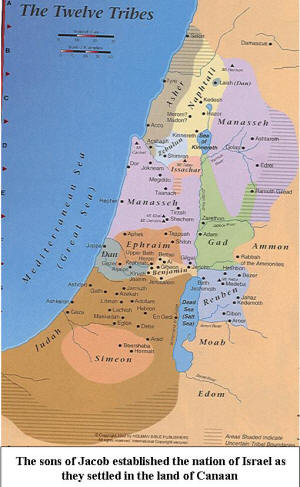 To
understand the story behind the Bible, we must know the
historical context. The message of the Bible is conveyed
through the history of its written pages. To
understand the story behind the Bible, we must know the
historical context. The message of the Bible is conveyed
through the history of its written pages.
The Bible
traces the story of humanity, from beginning to the end. The
Bible in essence is Godís plan of redemption for fallen man,
woven through the ages, projected forward to our eternal
destiny.
The Old
Testament records the creation of the universe and life, manís
perfection and fall. The Old Testament also reveals Godís plan
of redemption through a descendent Adam, the Messiah.
The first eleven chapters trace the first part of human history,
from Adam to Abraham. In Chapter 12, God separates the man
Abraham from his family and nation, and sends him to Moriah
(Jerusalem). Through Abraham, God would complete his plan of
redemption.
Through
Abrahamís offspring, Isaac and Jacob, God would redeem fallen
man to Himself. In rest of the Old Testament, from Genesis
12 to Malachi,
God details the plan of redemption through the Messiah. Through
prophets, God delivers His message to a fallen world. Prophets
establish the nature and character of the Messiah, who brings
redemption. Two pictures of Messiah emerge, one of a suffering
ďRighteousĒ servant (Isaiah 53) and the other of all-powerful
ruling king (Psalm 2).
In the Old
Testament era, God demonstrated manís inability for
self-redemption, showing the depravity of fallen human nature.
Only through Godís intervention, humanity could salvation come,
not self- effort.
In the New
Testament, the details of Messiah, foretold by the prophets
reach fulfillment in the person of Jesus Christ. The rejection
and death of the ďRighteousĒ servant, who pays for sin, fulfills
the words of Isaiah written 700-years before his birth.
Jesus becomes Godís sacrifice for humanities sins. The Gospels
record the life and teachings of Jesus, as Godís offer of
redemption is made available to the Gentile nations after
Israelís rejection. The book of Acts and the Epistles
(letters) record the advance of the good news (Gospel) of
redemption as it spreads abroad from Jerusalem. Finally, the
book of Revelation,
looks forward to the completion of Godís plan following the
return of Messiah, at the Second Coming, and the
establishment of the Kingdom of God and eternal state of
humanity.
The
Plan of Redemption
How
are we? Why are we here? What is our purpose and future? These
are the questions, which plague humanity. Both science and
religion attempt to answer these questions, creating a diverse
view of the universe from manís perspective. The Bible however,
is Godís answer, to a hopeless world trying to find its
purpose. The Bible is Godís love letter to humanity, His plan
for our salvation, and the final destiny of the saved.
The words in
the Bible, Godís revelation to man define our being, letting us
understand the meaning to our existence. Without Godís
revelation, we would have no way of knowing who we are, where we
came from or where we are going?
The Old
Testament records the history of humanity and Godís plan of
redemption, the New Testament records, Godís fulfillment and
completion of His plan.
The
history of the Bible
The
are many ways the history of the Bible can be divided, one
method is dividing the periods according to the methods of
atonement. Six periods of history can be distinguished in the
Bible, which allows us to divide scripture into understandable
sections.
∑
Adam to
Exodus: Before the Tabernacle
∑
Moses to
David: The Tabernacle
∑
Solomon to
the captivity: The First Temple
∑
Zerubabel to
Jesus: The Second Temple
∑
The New
Testament: Jesus Godís sacrifice
∑
The Early
Church: Redemption offered to the world
The
Mosaic Covenant,
established sacrifice in the law, to demonstrate the
righteousness required to be part of the Abrahamic Covenant,
these sacrifices pointed to the ultimate sacrifice, the
sacrifice of Godís son, the Messiah, who would die for the sins
of the world. Both the Tabernacle and the Temple illustrated the
holiness of God and the need for redemption.
|
Time
Period |
Adam to the Exodus
|
Book of the Bible |
|
??
To 1450 B.C. |
The Fall of Man
 God
created the heavens, the earth and mankind in 6-days
and rested on the 7th day. God created the first man
and woman, Adam and Eve. They had ďFree WillĒ to
obey or disobey God. They choose to reject Godís
command and listen to Satan, a fallen angel. By
rejecting Godís command, humanity became fallen and
corrupt. God however promised a Messiah who
would redeem man and restore him. (Genesis 3;15). God
created the heavens, the earth and mankind in 6-days
and rested on the 7th day. God created the first man
and woman, Adam and Eve. They had ďFree WillĒ to
obey or disobey God. They choose to reject Godís
command and listen to Satan, a fallen angel. By
rejecting Godís command, humanity became fallen and
corrupt. God however promised a Messiah who
would redeem man and restore him. (Genesis 3;15).
15
And I will put enmity Between you (Satan) and the
woman, And between your seed and her Seed; He shall
bruise your head, And you shall bruise His heel."
Genesis 3;15
Manís corrupt nature caused God to bring an
overall judgment on the human race, causing a flood
to kill both human and animal life. Noah, his
family and all the living animals that entered the
arc (the boat Noah built) were spared from Godís
judgment.
12 So God looked upon the earth, and indeed it was
corrupt; for all flesh had corrupted their way on
the earth. 13 And God said to Noah, "The end of all
flesh has come before Me, for the earth is filled
with violence through them; and behold, I will
destroy them with the earth. Genesis 6:12-13
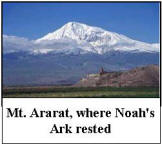
Everybody alive today is a descendent of Noah
and his family.
Following the flood, The arc landed in the
mountains of Ararat (Armenia), in modern day Turkey,
from there man as one tribe traveled to the lands of
the future Babylon,( Shunar, Summer). As one
people, humanity again began to rebel against God,
building the tower of Babel, so God caused a
confusion in language between Noahís descendents.
This confusion caused humanity to be dispersed over
the earth forming the different nations.
6
And the Lord said, "Indeed the people are one and
they all have one language, and this is what they
begin to do; now nothing that they propose to do
will be withheld from them. 7 "Come, let Us go down
and there confuse their language, that they may not
understand one another's speech." 8 So the Lord
scattered them abroad from there over the face of
all the earth, and they ceased building the city.
Genesis 11:6-8
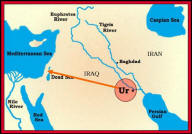
Abraham called
Abraham, a descendent of Shem, the second son of
Noah, left Ur, a city in Babylon, for Mt. Moriah
(Jerusalem) at Godís instruction. God promised
Abraham, to make him into a great nation. Isaac,
Abrahamís son, had two sons Jacob and Esau. Jacob
had 12 sons, who would later become the nation of
Israel. Jacob lived in the land of current day
Israel, but would live in Egypt for a time, before
being buried in Hebron with Abraham and Isaac. Godís
covenant would be transferred to Isaac and then to
Jacob. Jacob had twelve sons who would form the
tribes of Israel.
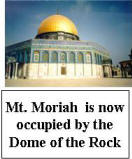 His brothers into Egypt sold Joseph, Jacobís second
youngest son. In Egypt, he became prime minister.
Famine struck the land of Canaan (Israel) forcing
his brothers to come to Egypt for food. There, they
met their brother who they sold as a slave years
earlier. Joseph forgave his brothers and they
settled in the land of Egypt in an area known as
Goshen with Joseph.
His brothers into Egypt sold Joseph, Jacobís second
youngest son. In Egypt, he became prime minister.
Famine struck the land of Canaan (Israel) forcing
his brothers to come to Egypt for food. There, they
met their brother who they sold as a slave years
earlier. Joseph forgave his brothers and they
settled in the land of Egypt in an area known as
Goshen with Joseph.
Over the next 400-years, the descendents of
Jacob multiplied. They numbered over 1,000,000, and
subsequently they became oppressed in the land of
Egypt, as slaves of a new Pharaoh. They cried out to
God of Abraham, Isaac and Jacob for rescue, and God
sent them Moses, a Hebrew raised in Pharaohís house. |
Genesis
Job |
|
|
Moses to David: The Tabernacle Period |
|
|
1450 B.C.
To
975 B.C. |
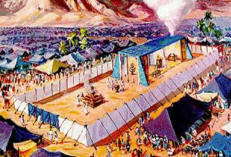 Moses, representing God to Pharaoh, delivered
plagues on Egypt, until Pharaoh freed the children
of Israel from captivity. Moses led the
descendents of Jacob (Israel) back toward the land
of Canaan, the Promised Land. God established the
Mosaic Covenant with the Tabernacle, as a
picture of the coming redemption through the
Messiah, who would die for the sins of the world.
(Hebrews 9, 10) The Messiah was Godís sacrifice for
our sins.
Moses, representing God to Pharaoh, delivered
plagues on Egypt, until Pharaoh freed the children
of Israel from captivity. Moses led the
descendents of Jacob (Israel) back toward the land
of Canaan, the Promised Land. God established the
Mosaic Covenant with the Tabernacle, as a
picture of the coming redemption through the
Messiah, who would die for the sins of the world.
(Hebrews 9, 10) The Messiah was Godís sacrifice for
our sins.
On the way, Israel rebelled against Moses and
wanted to return to Egypt. Because of rejecting
Godís leadership, at the hand of Moses, Israel
wandered the wilderness of Sinai for 40-years until
the rebellious generation died.
11
Then the Lord said to Moses: "How long will these
people reject Me? And how long will they not believe
Me, with all the signs which I have performed among
them? Numbers 14:11
Joshua succeeded Moses, he lead Israel into
Canaan. Israel conquered and settled a portion of
land and established a confederacy of tribes after
the 12 sons of Jacob. God ruled the tribes through
judges. Over the next 400-years, judges such as
Samson, Gideon, Jephthah, and Deborah
would lead the tribes of Israel against their
enemies.
In the course of time, the people requested a
king like the other nations, and God gave them Saul
as their first king in 1050 B.C., followed by David
1017 B.C.
David conquered the city of Jerusalem from the
Jebusites, a Canaanite tribe, making it the City
of David. Through prophets, God established
Davidís throne as an eternal throne later to be
ruled by his descendent, the Messiah, who
would one day rule the world with Jerusalem as the
capital city of the earth.
12 "When your (David) days are fulfilled and you
rest with your fathers, I will set up your seed
after you, who will come from your body, and I will
establish his kingdom. 13 "He shall build a house
for My name, and I will establish the throne of his
kingdom forever.16 "And your house and your kingdom
shall be established forever before you. Your throne
shall be established forever." ' " 2 Samuel
7:12-13,16 |
Exodus
Leviticus
Number
Deuter.
Joshua
Judges
Ruth
I
& II Samuel
Psalms
|
|
|
Solomon to the Captivity: First Temple Period |
|
|
975 B.C.
To
536 B.C. |
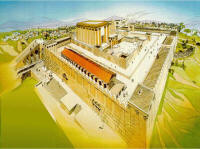 Solomon,
Davidís son succeeded his father as king over
Israel. He was permitted to build the Temple on Mt.
Moriah, which later became known as Solomonís
Temple. The Temple site was the same location,
where over 1000-years earlier, Solomonís forefather
Abraham was tested by God (Genesis 22, I Kings
8) Solomon,
Davidís son succeeded his father as king over
Israel. He was permitted to build the Temple on Mt.
Moriah, which later became known as Solomonís
Temple. The Temple site was the same location,
where over 1000-years earlier, Solomonís forefather
Abraham was tested by God (Genesis 22, I Kings
8)
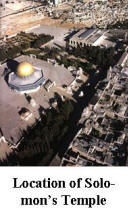
After Solomon, Israel became a divided kingdom,
the northern kingdom, known as Israel (10-tribes)
and the southern as Judah (Judah and Benjamin).
Eventually Israel and Judah tuned away from the
God of Abraham, Isaac and Jacob and started
worshipping the idols in the land of Canaan,
Baal, Ashtorah, Chemosh, etc. God warned Israel
through prophets, letting Israel know these
practices would result in their destruction. The
people rejected the messages of Isaiah, Jeremiah,
Hosea, Micah and others, and continued their idol
worship.
Using Godís pronouncements on Israel and Judahís
apostasy, through the prophets, the day of Godís
salvation was proclaimed, the coming Messiah, who
would redeem the sins of the world.
13 Behold, My Servant shall deal prudently; He shall
be exalted and extolled and be very high. 14 Just as
many were astonished at you, So His visage was
marred more than any man, And His form more than the
sons of men; 15 So shall He sprinkle many nations.
Kings shall shut their mouths at Him; For what had
not been told them they shall see, And what they had
not heard they shall consider. Isaiah 52:13-15
God responded by sending the armies of
Assyria in 722 B.C. to take the northern part of
Israel captive to the lands of Assyria. In 586
B.C. the Babylonians, destroyed Jerusalem and
Solomonís Temple taking those left into Babylon for
a period of 70 years. Among the captives were the
prophets Daniel and Ezekiel.
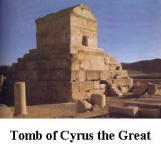 At
the end of 70 years, the Persians defeated Babylon
under Cyrus the Great, he allowed the Jews to
return to the land of Israel. Cyrus also allowed
the Jews to begin reconstruction of their Temple in
536 B.C., construction was completed in 516 B.C.,
exactly 70-years after the Temple was destroyed. At
the end of 70 years, the Persians defeated Babylon
under Cyrus the Great, he allowed the Jews to
return to the land of Israel. Cyrus also allowed
the Jews to begin reconstruction of their Temple in
536 B.C., construction was completed in 516 B.C.,
exactly 70-years after the Temple was destroyed.
The Temple like the Tabernacle was a picture of
Godís redemption, through the coming sacrifice of
Messiah, who would atone for the sins of the world.
9
And they made His grave with the wicked-But with the
rich at His death, Because He had done no violence,
Nor was any deceit in His mouth. 10 Yet it pleased
the Lord to bruise Him; He has put Him to grief.
When You make His soul an offering for sin, He shall
see His seed, He shall prolong His days, And the
pleasure of the Lord shall prosper in His hand. 11
He shall see the labor of His soul, and be
satisfied. By His knowledge My righteous Servant
shall justify many, For He shall bear their
iniquities. Isaiah 53:9-11
|
Ecclesiastes
Proverbs
I
& II Kings
I
& II
Chron.
Isaiah
Amos
Hosea
Micah
Jonah
Joel
Jeremiah
Lam.
Ezekiel
Daniel
|
|
|
Zerubabel to Jesus; 2nd Temple Period,
Inter-Testament Period |
|
|
536 B.C.
To
4 B.C. |
In Babylon, Israel was humbled becoming
servants of the Babylonians. However, in Babylon God
raised prophets like Daniel who became the prime
minister of Babylon under king Nebuchadnezzar
(Daniel chapters 1-4). Through Daniel, God revealed
his plans for Israel and the world, and the coming
of His Messiah. Giving the exact month, year
and day of Messiahís death (Daniel 9;24-27)
"And after the sixty-two weeks Messiah shall be cut
off, but not for Himself; And the people of the
prince who is to come Shall destroy the city and the
sanctuary. Daniel 9:26a
In 539 B.C. Cyrus the Great, head of a
Persian-Median kingdom defeated Babylon. He allowed
the Jews to return to the land of Israel and rebuild
their Temple. In 516 B.C., seventy years after the
Temple was destroyed, the Second Temple was
completed. During this period, God spoke through
the prophets, Zechariah, Haggai, and
Malachi to encourage Israel about the coming
plan of redemption through the Messiah.
Malachi was the last prophet of the age, writing
about 425 B.C.
1
"Behold, I send My messenger, And he will prepare
the way before Me. And the Lord, whom you seek, Will
suddenly come to His temple, Even the Messenger of
the covenant, In whom you delight. Behold, He is
coming," Says the Lord of hosts. 2 "But who can
endure the day of His coming? And who can stand when
He appears? For He is like a refiner's fire And like
launderer's soap. Malachi 3:1-2
Inter-Testament Period
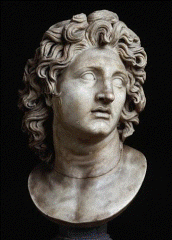 Malachi wrote during the period of the Persian
control of Jerusalem, less then 100-years later, the
Persians were defeated by the rising power to the
west, the Grecian kingdom led by Alexander the
Great. In 331 B.C., Alexander defeated Persian
control of Judea.
Malachi wrote during the period of the Persian
control of Jerusalem, less then 100-years later, the
Persians were defeated by the rising power to the
west, the Grecian kingdom led by Alexander the
Great. In 331 B.C., Alexander defeated Persian
control of Judea.
Alexander allowed the Jews to maintain their
worship and sacrifice as he went on to fight Persia
in the east. In 323 B.C., Alexander the Great died
in city of Babylon, and his kingdom was divided
between his four generals.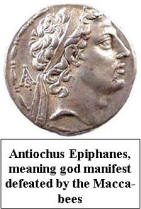
Two of his generals, Seleucid and
Ptolemy and their descendents, would fight over
the land of Jerusalem and Judah for the next
200-years. Then in 168 B.C. Antiochus Epiphanes
decided to unify his Seleucid Greek Kingdom, under
the Greek religion, meaning the Jewish faith was to
be eliminated. This caused a Jewish revolt known as
the Maccabean War, which ended in the
creation of an independent Jewish Kingdom for about
100-years, and the celebration of Hanukah.
The kingdom came to an end when, two brothers
Aristobulus II and Hyrcanus II requested
Romans help to settle their dispute. Pompey
the Roman general stepped in, conquered Jerusalem
and established Roman control over Judah in 63 B.C.
Later Herod the Great, a friend of Rome,
was installed on the Jewish throne until his death
in 4 B.C., establishing the Herodian dynasty in
Judea/Palestine.
|
Haggai
Zechariah
Ester
Ezra
Nehemiah
Malachi |
|
|
New Testament Period |
|
|
4 B.C.
To
A.D. 95 |
The New Testament records the life, teachings
and commands of Jesus Christ and His church. Jesus
fulfilled the prophecies regarding the suffering
Messiah, in the Old Testament. The Messiah, would
suffer for the sins of the world, paying the penalty
of sin, as foreshadowed in the Mosaic Covenant.
(Hebrew 9,10)
Two portraits of Messiah emerge in the Old
Testament, one is the picture of a ďRighteousĒ
suffering Servant, who dies for the sins of the
world (Isaiah 53). The other is King Messiah who
rules over the earth (Psalm 2). The death of Jesus
in A.D. 33, fulfilled the prophecies regarding the
suffering servant. At His Second Coming, he will
fulfill the prophecies regarding King Messiah, who
reigns over the earth.
His death brought redemption to humanity, and
the mission of the church was to proclaim salvation
and redemption to the fallen world. The Gospels
were the written record of the life and teachings of
Jesus the Messiah.
The Acts of the Apostles record the history of the
early church and its establishment in the Gentile
nations. The Epistles record the teachings of the
apostles and instructions to the church. The book
of Revelation records Christís instructions to the
church, events leading to the return of Christ and
the eternal state of humanity. Revelation completes
the picture of Genesis, which records the beginning;
Revelation reveals the end of all things.
|
Matthew
Mark
Luke
John
Acts
Epistles
Revelation |
|
|
Early Church Period |
|
|
95 A.D.
To
325 A.D. |
As recorded in the book of Acts, the church began to
spread throughout the Roman world. The spread of
the church caused many to turn from their Greek and
Roman gods and goddess. An early example of their
success is illustrated in Acts 19 as the men of
Ephesus become alarmed at their loss of goddess
business.
24 For a certain man named Demetrius, a silversmith,
who made silver shrines of Diana, brought no small
profit to the craftsmen. 25 He called them together
with the workers of similar occupation, and said:
"Men, you know that we have our prosperity by this
trade. 26 "Moreover you see and hear that not only
at Ephesus, but throughout almost all Asia, this
Paul has persuaded and turned away many people,
saying that they are not gods which are made with
hands. 27 "So not only is this trade of ours in
danger of falling into disrepute, but also the
temple of the great goddess Diana may be despised
and her magnificence destroyed, whom all Asia and
the world worship." 28 Now when they heard this,
they were full of wrath and cried out, saying,
"Great is Diana of the Ephesians!" Acts 19:24-28 a
@ 51-52 A.D.
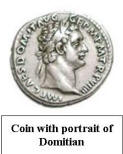 The spread of Christianity caused greater
persecution, John one of the last remaining
disciples was the bishop of Ephesus, when he was
exiled to Patmos during the persecution of
Domitian. On Patmos, John received the
Revelation of Jesus Christ, a letter to the
seven churches foretelling a period of persecution
and apostasy within some of the churches. Jesus
however declared the events leading to the Second
Coming, and the eternal state of humanity despite
the persecution and apostasy.
The spread of Christianity caused greater
persecution, John one of the last remaining
disciples was the bishop of Ephesus, when he was
exiled to Patmos during the persecution of
Domitian. On Patmos, John received the
Revelation of Jesus Christ, a letter to the
seven churches foretelling a period of persecution
and apostasy within some of the churches. Jesus
however declared the events leading to the Second
Coming, and the eternal state of humanity despite
the persecution and apostasy.
After John there were periods of persecution
where Roman officials sent Christians to the arena
to be torn apart by lions and burned copies of the
scriptures. This persecution reached a climax
during the reigns of
Diocletian
303-305 and Galerius in 303-311 A.D.
 In
312 A.D., Constantine came to power, after the
Battle of Milvian Bridge, seeing a vision of the
cross, he later proclaimed himself a Christian, and
issued the Edict of Milan ending legalized
persecution of Christians. In
312 A.D., Constantine came to power, after the
Battle of Milvian Bridge, seeing a vision of the
cross, he later proclaimed himself a Christian, and
issued the Edict of Milan ending legalized
persecution of Christians.
Thus Christianity became established as the religion
of the Roman Empire by the beginning of the fourth
century.
|
|
|


![]() What
is the history behind the Bible? (Printer
friendly version)
What
is the history behind the Bible? (Printer
friendly version)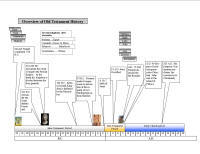
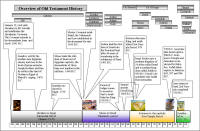
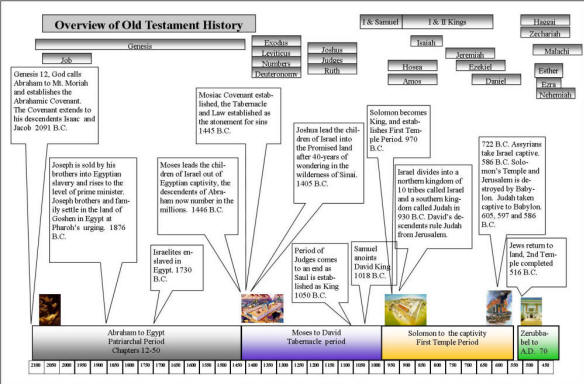
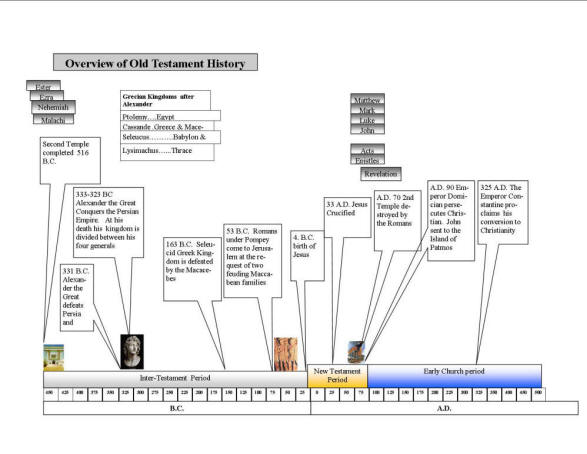
 To
understand the story behind the Bible, we must know the
historical context. The message of the Bible is conveyed
through the history of its written pages.
To
understand the story behind the Bible, we must know the
historical context. The message of the Bible is conveyed
through the history of its written pages.  God
created the heavens, the earth and mankind in 6-days
and rested on the 7th day. God created the first man
and woman, Adam and Eve. They had ďFree WillĒ to
obey or disobey God. They choose to reject Godís
command and listen to Satan, a fallen angel. By
rejecting Godís command, humanity became fallen and
corrupt. God however promised a Messiah who
would redeem man and restore him. (Genesis 3;15).
God
created the heavens, the earth and mankind in 6-days
and rested on the 7th day. God created the first man
and woman, Adam and Eve. They had ďFree WillĒ to
obey or disobey God. They choose to reject Godís
command and listen to Satan, a fallen angel. By
rejecting Godís command, humanity became fallen and
corrupt. God however promised a Messiah who
would redeem man and restore him. (Genesis 3;15).


 His brothers into Egypt sold Joseph, Jacobís second
youngest son. In Egypt, he became prime minister.
Famine struck the land of Canaan (Israel) forcing
his brothers to come to Egypt for food. There, they
met their brother who they sold as a slave years
earlier. Joseph forgave his brothers and they
settled in the land of Egypt in an area known as
Goshen with Joseph.
His brothers into Egypt sold Joseph, Jacobís second
youngest son. In Egypt, he became prime minister.
Famine struck the land of Canaan (Israel) forcing
his brothers to come to Egypt for food. There, they
met their brother who they sold as a slave years
earlier. Joseph forgave his brothers and they
settled in the land of Egypt in an area known as
Goshen with Joseph.
 Solomon,
Davidís son succeeded his father as king over
Israel. He was permitted to build the Temple on Mt.
Moriah, which later became known as Solomonís
Temple. The Temple site was the same location,
where over 1000-years earlier, Solomonís forefather
Abraham was tested by God (Genesis 22, I Kings
8)
Solomon,
Davidís son succeeded his father as king over
Israel. He was permitted to build the Temple on Mt.
Moriah, which later became known as Solomonís
Temple. The Temple site was the same location,
where over 1000-years earlier, Solomonís forefather
Abraham was tested by God (Genesis 22, I Kings
8) 
 At
the end of 70 years, the Persians defeated Babylon
under Cyrus the Great, he allowed the Jews to
return to the land of Israel. Cyrus also allowed
the Jews to begin reconstruction of their Temple in
536 B.C., construction was completed in 516 B.C.,
exactly 70-years after the Temple was destroyed.
At
the end of 70 years, the Persians defeated Babylon
under Cyrus the Great, he allowed the Jews to
return to the land of Israel. Cyrus also allowed
the Jews to begin reconstruction of their Temple in
536 B.C., construction was completed in 516 B.C.,
exactly 70-years after the Temple was destroyed.

 The spread of Christianity caused greater
persecution, John one of the last remaining
disciples was the bishop of Ephesus, when he was
exiled to Patmos during the persecution of
Domitian. On Patmos, John received the
Revelation of Jesus Christ, a letter to the
seven churches foretelling a period of persecution
and apostasy within some of the churches. Jesus
however declared the events leading to the Second
Coming, and the eternal state of humanity despite
the persecution and apostasy.
The spread of Christianity caused greater
persecution, John one of the last remaining
disciples was the bishop of Ephesus, when he was
exiled to Patmos during the persecution of
Domitian. On Patmos, John received the
Revelation of Jesus Christ, a letter to the
seven churches foretelling a period of persecution
and apostasy within some of the churches. Jesus
however declared the events leading to the Second
Coming, and the eternal state of humanity despite
the persecution and apostasy.